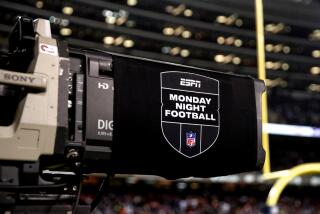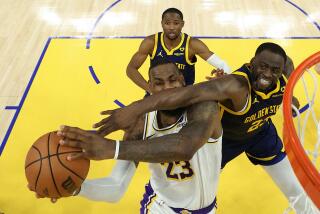Connecting the Net with your TV set
- Share via
Buyers of this year’s most advanced televisions might notice a curious new feature -- a little jack that connects the sets directly to the Internet.
For now, the capabilities are modest. Viewers can’t surf the Web as they can on their computers, but they can use their remote controls to get updated local weather forecasts, personalized stock quotes, on-demand access to a handful of TV shows such as “CSI: Crime Scene Investigation” and thousands of YouTube videos.
But the Web connections could eventually upend the way TV programs have been distributed for decades. The goal is to one day replace every set-top device -- cable boxes, TiVos, media center computers, stereos and game consoles -- so all you need is a TV set that does it all, via the Internet.
As broadband gets faster, TVs get more powerful and entertainment companies put more content online, viewers might be able to call up any show, movie, song or amateur video at any time without needing local TV stations or cable subscriptions.
“An Internet connection gives consumers the opportunity to define the experience they want on their TVs,” said Randy Waynick, senior vice president of marketing for Sony Electronics Inc., which has signed deals to bring content from CBS Interactive, Yahoo Inc., Sports Illustrated and others to its Web-enabled Bravia sets. “This is TV at your schedule.”
If that scenario seems a little futuristic, it is. A lot would have to change before viewers get whatever they want, whenever they want it. For one thing, the Internet isn’t sturdy enough yet to deliver high-definition videos to jumbo-sized TVs. For another, TV sets don’t have the computing power to process big video streams.
Also crucial is figuring out the navigation system: How do you let viewers find what they want on the big Internet? Those wireless keyboards that let hotel guests surf the Web on their TVs haven’t caught on.
“I don’t think there’s a replacement for sitting on your couch with a remote control and watching live linear television,” said Dan Fawcett, president of Fox Digital Media.
Manufacturers such as Sony, Sharp Electronics Corp. and Panasonic Consumer Electronics Co. see a Web connection as a competitive edge.
But it’s also a foothold in the future of television. Millions of Americans are planning to purchase new sets ahead of the national transition to an all-digital broadcast in February 2009, when TV stations will abandon their old analog frequencies. Households that still tune in to free, over-the-air TV will need a new TV or digital converter box to watch shows.
“The Internet is the new ether,” said Paul Liao, chief technical officer for Panasonic. “First you had broadcasting over the air. Then you had cable, and then satellite. Now fiber optics are bringing programming to the TV.”
Television makers face competition from Apple Inc., Microsoft Corp. and TiVo Inc., which are among the many companies trying to connect the PC with the TV.
Few consumers have embraced these attempts. That’s because people don’t want to buy another box to connect to their television sets, said George Kliavkoff, NBC Universal’s chief digital officer. He said that left three viable players: set-top boxes from cable and satellite providers, video game consoles and the TVs themselves.
“I don’t know who wins, but I think those are the only folks who have a chance,” Kliavkoff said. “It brings the ability to have unlimited channel capacity, personalized channels -- a celestial video jukebox in the sky.”
In addition to technical hurdles, there’s a business problem: winning shelf space in stores. Retailers make “a ton of money” selling DVDs and might balk at selling a network-connected TV that could potentially undercut the sale of home movies, said Kurt Scherf, principal analyst for Parks Associates in Dallas.
Electronics makers have two powerful allies: TV networks and Internet companies such as Google Inc.
For networks, providing shows via the Internet broadens their potential audience and creates opportunities for interactive advertising.
Web search guru Google also is seeking new advertising formats, especially video. In January it announced a deal to make YouTube videos available on Internet-connected Panasonic sets.
“We are making a video platform that gives users a sense of infinite choice,” said David Eun, Google’s vice president of content partnerships. “This is about making content accessible to as many viewers as possible.”
That’s potentially bad news for local TV stations, which for decades have collected money for distributing networks’ shows. Local stations still retain exclusive first-run rights to prime-time shows, and the networks are trying to maintain good relationships with the affiliates, allowing them to offer programming on their websites.
Still, Internet distribution lets TV viewers go around affiliates to watch shows.
“When you do these direct deals between TV manufacturers and content providers, the entity getting squeezed out is the middleman,” said Will Richmond, president of Broadband Directions, a market intelligence and consulting firm.
For now, at least, the thought of a viewer using an Internet-connected television to stream an episode of “30 Rock” isn’t causing insomnia for Terry Mackin, executive vice president of Hearst-Argyle Television Inc., which owns 26 television stations.
“You might be able to see ‘The Office’ elsewhere, but people want their local community news and information more than they want anything from us,” he said. “We’re making that adjustment.”
Cable companies say they aren’t worried either.
“Cable is a far superior technology when it comes to letting you watch what you want, when you want, on your TV,” said Kevin Leddy, senior vice president of the advanced technology group at Time Warner Cable.
Its digital video recorders let viewers record shows and watch them at their leisure. It’s also beefing up its video-on-demand service and, later this year, introducing a “start over” feature that lets viewers watch a show they missed up to 48 hours after it airs.
There are a lot of big players jockeying for supremacy, and consumers will no doubt be confused, Richmond said. But they might win in the end.
“Consumers benefit when there’s choice, competition and better technology,” he said. “We’re now getting a perfect storm of all three.”






